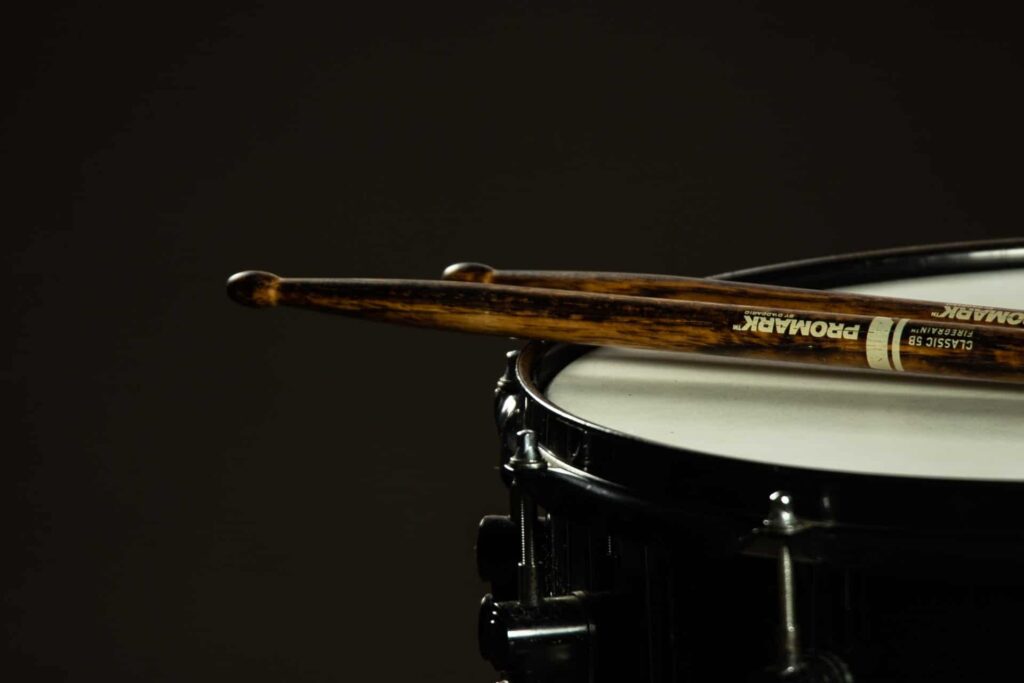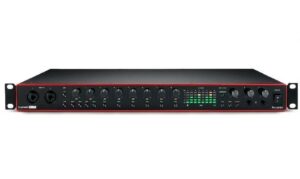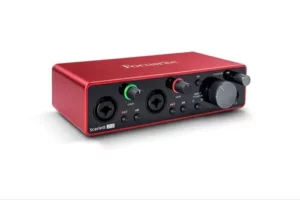For a drummer a drum stick is essentially an extension of their hand so finding the right stick is important. There are a lot of different types of drum sticks and drum stick sizes to choose from and it can certainly be confusing even for a seasoned drummer.
The types of drum sticks can differ based of different factors like material, length, tip type and shape, as well as taper.
Types of Drum Sticks
In the broader sense drum sticks can typically be of 4 types:
1. Traditional Sticks
These are your normal (typically wooden) drum sticks which are the ones used most commonly by drummers. This is the category we will be exploring further below.
Below is an example of the traditional wooden drum sticks.
2. Brushes
Brushes are extremely soft and used in genres like jazz, where a lot of texture is required. Playing style of brushes is completely different from those of traditional drum sticks.
Below is an example of the drum brushes.
3. Rods
Rods are basically a bunch of thin sticks bound together and they lie somewhere between brushes and drumsticks in terms of volume. They can give you a good balance and are great for acoustic settings where you need to control the drum volume.
Below is an example of the drum rods.
4. Mallets
Mallets have a beater at the end of the stick and give a much thicker sound. They are also used with cymbals for buildups and swells where a traditional stick just wont work as well.
Below is an example of drum mallets.
Now lets explore further your traditional type of drum sticks. These can vary based on several factors, which include material, size and tip. and taper.
The Different Sizes of Drum Sticks [The Broad Category]
When buying drum sticks you would noticed numbers and letters for the model name.
The sizes are split typically into 2,5 and 7 with 7 being the lightest and 2 being the heaviest. As you can guess size 5 is the most commonly used since it works well for all genres of music.
Now with these numbers you would have noticed letters A or B. B sticks are slightly heavier and meant for “bands”, while A sticks are slightly lighter and traditionally for “orchestras”.
Which drum stick size is right for you?
A majority of beginner level drummers start with 5A sticks since they have a medium weight and work well for most genres. You can experiment with 5A or 5B in the beginning.
If you start playing music which is slightly softer then 7A sticks would work great and if you start playing heavier music like rock or metal then size 2B sticks could work great.
Keep in mind though that softer music doesn’t necessarily mean softer sticks or vice versa. Many times metal drummers prefer lighter 7 size sticks which help them generate more speed with lesser exertion. All in all it comes down to what feels right to your playing style.
Anatomy of the Drum Stick
Within these sizes there are a bunch of factors which can govern your tone and preference of stick. Lets have a look below at all the different factors that come into play.
1. The Different Kinds of Material
a. Wood
A majority of the drum sticks in the world are made from wood, namely Hickory, Maple and Oak. They each have their own pros and cons.
Typically hickory sticks are the most common. They are great at absorbing shock and work well with the majority of drummers. As per The Vault, Manufactures like Vic Firth produce more than 85% of their sticks with Hickory.
Oak is slightly heavier than Hickory which gives manufacturers the ability to make slightly thinner sticks with the same weight, while Maple is slightly lighter which makes it possible to have thicker sticks with the lesser weight.
There are also other woods like hornbeam and persimmon but these comprise a fraction of the overall production.
b. Other materials like carbon fiber and metal
Metal sticks are of course more durable but slightly heavier and may not feel as comfortable as wooden sticks. This makes them good for some metal players but they also put a lot of strain on cymbals which can be a big problem.
Carbon fiber on the other hand has a similar feel to hickory and is light yet very durable. The downside is much higher costs and availability of fewer models.
Which drum stick material is right for you?
If you are a beginner then definitely choose a hickory drum stick which is the most common type. Once you get the feel of playing with this material then you can change depending on your preference. If the stick is feeling too heavy for your playing style, then you can shift to a maple drum stick or if it feels lighter you can shift towards oak.
If you are slightly more advanced then of course go ahead and experiment with other wood types as well as carbon fiber and metal sticks.
2. The Tip Shape and Material
The tip material is typically either wooden or nylon for most drum sticks unless they are metal or carbon fiber sticks. Nylon tips create a significantly brighter tone than wooden tips and also tend to last much longer.
There are also numerous shapes of the tips and these too can change your tone and feel. These are primarily:
1. Oval – very broad range
2. Barrel – punchy and loud
3. Acorn – full and fat
4. Teardrop – low and dark tones
5. Ball – bright crisp and clear
Which drum stick tip is right for you?
If you are a beginner we would suggest starting with wooden tips with either the oval or tear drop shape. Slowly you can switch to different type based on your music type.
3. The Length
The length of the drum stick can completely change how it feels in your hand while playing. Even a stick with the same thickness but different length will feel extremely different. Longer sticks can have more range and typically feel heavier. On the other hand smaller sticks feel slightly lighter.
As per Sonomusic, typical length of the drum stick is about 15-17.5 inches.
Which drum stick length is right for you?
A standard 16 inch drum stick would work best for beginners and you can explore other options as you start gaining experience.
4. The Thickness
A higher thickness of the drum stick will make it more durable and louder but will also be more exerting. On the other hand a thinner stick can provide more speed and a lighter feel.
The ‘different sizes of drum sticks” portion of the blog above gives details about the stick sizes. These sizes broadly refer to the stick thickness with 2B being the heaviest and thickest and 7A being the thinnest and lightest.
The thickness can differ for a type of drum stick when comparing different brands but overall chart remains true within a single brand.
Which drum stick thickness is right for you?
As discussed above if you are a beginner then a 5A size would work best in the beginning. This can later on be changed as you develop your playing style.
5. The Taper
The taper will change the feel and balance of your drum stick. A longer taper in the stick makes it respond faster whereas a stick with a shorter taper makes it sturdier and more powerful with lesser rebound.
Which drum stick thickness is right for you?
For the feel of more power and a front heavy stick go for a shorter taper whereas if you prefer a lighter feeling stick with more response then go for a longer taper.
Conclusion
The world of drum sticks is absolutely huge and it can get extremely confusing figuring out which type of drum sticks work best for you. The best strategy is to start at a neutral place with standard stick sizes and slowly start experimenting with different drum sticks.
Understand and build your own playing style and keep trying until you find those drumsticks which match you perfectly.
The Author, Naman Sachdev, is a metal drummer and owner of Whack Studio.









